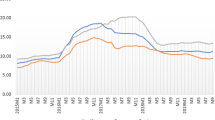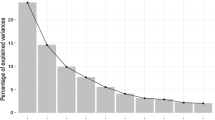Abstract
This paper examines the effects of monetary policy on macroeconomic variables in Pakistan’s economy using a data-rich environment. We used the factor-augmented vector autoregressive (FAVAR) methodology, which contains 115 monthly variables for the period 1992:01 to 2010:12. We compared the results of VAR and FAVAR model and the results showed that FAVAR model explains the effects of monetary policy which are consistent with the theory and better than the VAR model. VAR model shows the existence of price puzzle and liquidity puzzle in Pakistan while FAVAR model did not provide any evidence of puzzles. Interest rate negatively influences prices, hence interest rate is a good instrument for controlling inflation in Pakistan but it takes a lag of 5 months. The transmission of monetary policy shock is faster in case of prices as compared to output in Pakistan. FAVAR model supports the effectiveness of interest rate channel in Pakistan.








Similar content being viewed by others
Notes
SBP (2002) Pakistan: Financial Sector Assessment 1990–2000.
SBP (2002) Pakistan: Financial Sector Assessment 1990–2000.
Discount rate is the officially announced instrument of monetary policy in Pakistan. Even though there is not much variation in it, but at monthly frequency it has sufficient variation to capture the dynamics of the monetary policy in Pakistan.
The Cholesky Decomposition implies short run restrictions on the error term of the VAR model. It is a standard assumption in monetary policy analysis which enables transformation of the errors of the reduced form of the VAR model into structural innovations. This procedure is well explained in Bagliano and Favero (1998) and Christiano et al. (1999).
References
Agha AI, Ahmed N, Mubarik YA, Shah H (2005) Transmission mechanism of monetary policy in Pakistan. SBP-Res Bull 1:1–23
Bagliano FC, Favero CA (1998) Measuring monetary policy with VAR models: an evaluation. Eur Econ Rev 42:1069–1112
Bai J, Ng S (2002) Determining the number of factors in approximate factor models. Econometrica 70:191–221
Bernanke BS, Blinder AS (1992) The federal funds rate and the channels of monetary transmission. Am Econ Rev 82:901–921
Bernanke BS, Boivin J (2003) Monetary policy in a data-rich environment. J Monet Econ 50:525–546
Bernanke BS, Boivin J, Eliasz PS (2005) Measuring the effects of monetary policy: a factor-augmented vector autoregressive (FAVAR) approach. Quart J Econ 120:387–422
Blaes B (2009) Money and monetary policy transmission in the Euro Area: evidence from FAVAR and VAR approaches. Dtsch Bundesbank Discuss Pap No 18
Breitung J, Eickmeier S (2005) Dynamic factor models. Dtsch Bundesbank Discuss Pap No 38
Carvalho MD, Junior JLR (2009) Identification of monetary policy shocks and its effects: FAVAR methodology for the Brazilian economy. Braz Rev Econom 29:285–313
Christiano LJ, Eichenbaum M, Evans CL (1999) Monetary policy shocks: what have we learned and to what end? In: Taylor JB, Woodford M (eds) Handbook of macroeconomics. Elsevier, Amsterdam, pp 65–148
Hamilton JD (1994) Time series analysis. Princeton University Press, Princeton
Hussain K (2009) Monetary policy channels of Pakistan and their impact on real GDP and inflation. Cent Int Dev Grad Stud Work Pap No 40
Javid M, Munir K (2011) The price puzzle and monetary policy transmission mechanism in Pakistan: structural vector autoregressive approach. Pak Dev Rev 49:449–460
Kabundi A, Ngwenya N (2011) Assessing monetary policy in South Africa in a data-rich environment. S Afr J Econ 79:91–107
Khan MH (2008) Short run effects of an unanticipated change in monetary policy: interpreting macroeconomic dynamics in Pakistan. SBP-Res Bull 4:1–30
Lagana G, Mountford A (2005) Measuring monetary policy in the UK: a factor-augmented vector autoregression model approach. Manch Sch 73:77–98
Lutkepohl H (2005) New introduction to multiple time series analysis. Springer, Berlin
Miyao R (2002) The effects of monetary policy in Japan. J Money Credit Bank 34:376–392
Pakistan Bureau of Statistics. Monthly Bulletin of Statistics. Government of Pakistan (various issues)
Peersman G, Smets F (2001) The monetary transmission mechanism in the Euro Area: more evidence from VAR analysis. Eur Cent Bank Work Pap No 91
Senbet D (2008) Measuring the impact and international transmission of monetary policy: a factor-augmented vector autoregressive (FAVAR) approach. Eur J Econ Financ Adm Sci 13:121–143
Shibamoto M (2007) An analysis of monetary policy shocks in Japan: a factor augmented vector autoregressive approach. Jpn Econ Rev 58:484–503
Sims CA (1980) Macroeconomics and reality. Econometrica 48:1–48
Sims CA (1992) Interpreting the macroeconomic time series facts: the effects of monetary policy. Eur Econ Rev 36:975–1000
Soares R (2011) Assessing monetary policy in the Euro area: a factor-augmented VAR approach. Banco Port Work Pap No 11
State Bank of Pakistan. Monthly Statistical Bulletin. State Bank of Pakistan (various issues)
Stock JH, Watson MW (2002) Macroeconomic forecasting using diffusion indexes. J Bus Econ Stat 20: 147–162
Walsh CE (2010) Monetary theory and policy. MIT Press, Cambridge, MA
Author information
Authors and Affiliations
Corresponding author
Additional information
This paper is from the PhD Dissertation submitted at the Pakistan Institute of Development Economics, Islamabad, Pakistan (2012).
Appendix
Appendix
The data listed in Table 2 describe the complete description of the variable, define whether it considered slow or fast moving variables, and the transformation applied to the series to make it stationary.
Rights and permissions
About this article
Cite this article
Munir, K., Qayyum, A. Measuring the effects of monetary policy in Pakistan: a factor-augmented vector autoregressive approach. Empir Econ 46, 843–864 (2014). https://doi.org/10.1007/s00181-013-0702-9
Received:
Accepted:
Published:
Issue Date:
DOI: https://doi.org/10.1007/s00181-013-0702-9




